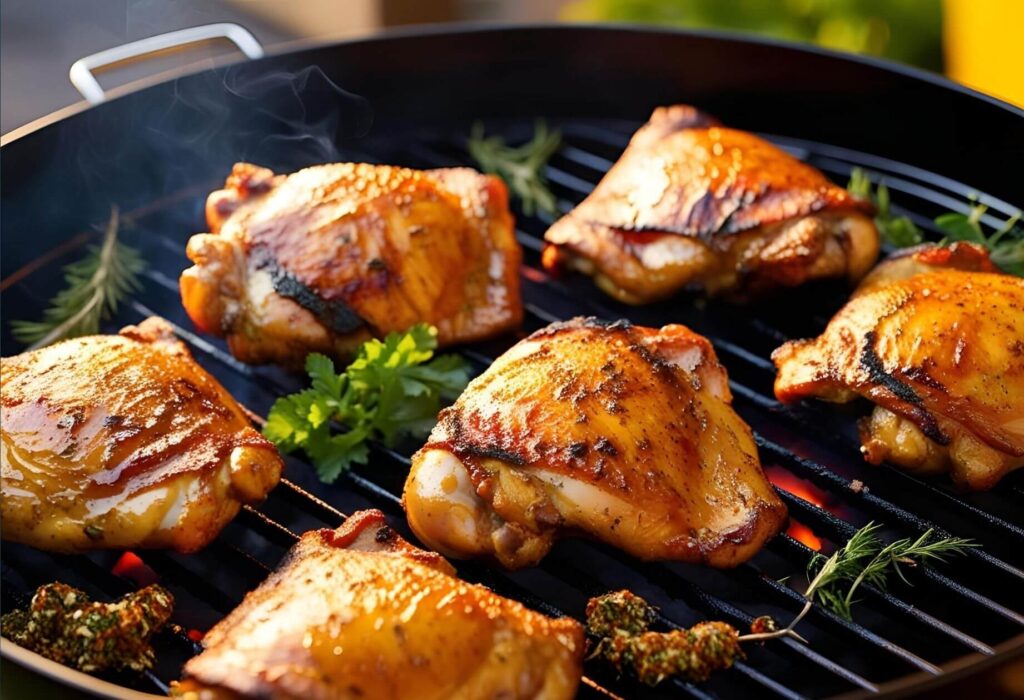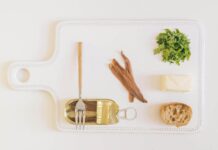I’ve been cooking chicken thighs for over 15 years, and I still remember the first time I boiled them – what a disaster! The meat was tough, bland, and I practically needed a saw to cut through it. After countless Sunday dinners and weeknight meals, I’ve finally nailed the technique, and trust me, there’s an art to it.
Chicken thighs are honestly my favorite part of the bird – they’re practically impossible to mess up (well, almost) and they have this incredible rich flavor that chicken breasts just can’t match. But there’s one question I get ALL the time from friends and family: how long to boil chicken thighs without turning them into rubber? It’s trickier than you’d think!
My mother-in-law actually taught me the secret years ago while we were making her famous chicken soup. Whether you’re throwing together a quick dinner, meal prepping for the week, or building the base for another recipe entirely, getting the timing right makes all the difference in the world. What follows are my hard-earned kitchen lessons that’ll save you from the chewy chicken mistakes I made for years. Grab a pot and let’s get cooking!
Quick Summary
Look, I know you might be in a hurry, so here’s the quick version: Bone-in chicken thighs need about 20-25 minutes of gentle boiling, while the boneless ones cook faster at around 15-20 minutes. Always make sure they hit 165°F inside (I learned this the hard way after a memorable dinner party mishap in 2019). Throw some garlic and herbs in that water, folks! It makes a WORLD of difference. And for heaven’s sake, let them rest before cutting – my dad never does this and wonders why his chicken always ends up dry as the Sahara.
Key Takeaways
| Chicken Thigh Type | Boiling Time | Internal Temperature | Rest Time |
| Bone-in | 20-25 minutes | 165°F (74°C) | 5-10 minutes |
| Boneless | 15-20 minutes | 165°F (74°C) | 5 minutes |
| Frozen bone-in | 40-45 minutes | 165°F (74°C) | 5-10 minutes |
| Frozen boneless | 30-35 minutes | 165°F (74°C) | 5 minutes |
How Long to Boil Chicken Thighs: Detailed Breakdown
OK, so here’s the deal with boiling chicken thighs – timing is EVERYTHING. You can’t just toss them in water, set a timer for “whenever,” and expect miracles. My aunt Janet does this and then has the nerve to complain about tough chicken! I’ve literally had to bite my tongue at family gatherings.
The funny thing is, boiling seems so straightforward, right? Water + chicken + heat = dinner. But there’s actually quite a bit going on in that pot that can make or break your meal.
Bone-in Chicken Thighs
I’m a bone-in girl myself – I think they have WAY more flavor. Plus, there’s something satisfying about that moment when the meat just slides off the bone… chef’s kiss!
- Regular boil (rolling bubbles): 20-25 minutes
- Gentle simmer (occasional bubbles): 25-30 minutes
Here’s my pro tip from years of Sunday cooking: bone-in thighs are your friend if you tend to get distracted (hello, fellow parents!). That bone is like a built-in insurance policy. I’ve left them on for an extra 5 minutes while breaking up a fight between my kids, and they were still juicy. Try that with chicken breast – I dare you!
Boneless Chicken Thighs
I keep boneless thighs in the freezer for busy weeknights when I’m racing the clock.
- Regular boil: 15-20 minutes
- Gentle simmer: 18-22 minutes
Take it from someone who ruined dinner last Tuesday – with boneless thighs, set a timer! They go from perfect to hockey pucks FAST. My husband still teases me about the “chicken jerky incident” from when we first started dating. Go for the gentle simmer if you can – your chicken will thank you by not turning into shoe leather.
Starting From Frozen
We’ve all been there – it’s 5:30 PM, you forgot to thaw the chicken, and everyone’s asking “what’s for dinner?” Been there about a thousand times! While I don’t recommend making this a habit (my mother would be horrified), you absolutely CAN boil chicken thighs straight from frozen.
- Frozen bone-in thighs: 40-45 minutes
- Frozen boneless thighs: 30-35 minutes
Last winter during that crazy snowstorm, I couldn’t get to the store and had to cook from my freezer stash for days. BIG LESSON: you really, really need to check the internal temperature when cooking from frozen. Parts cook unevenly and nothing’s worse than cutting into pink chicken at the bone. Ugh.
By the way, if you’re like me and occasionally forget to plan ahead, you might find how long to cook lasagna and other make-ahead meals super helpful. I’ve started doing Sunday prep and it’s been a total game-changer for hectic weeknights.
The Perfect Boiling Method
I’ve boiled approximately one million chicken thighs over the years (slight exaggeration, but you get my point), and I’ve got the method down to a science. Follow these steps and I promise you’ll get it right every time:
- Start with cold water: This isn’t just cooking snobbery – it actually matters! Place your chicken thighs in a pot and cover with cold water by about an inch. My grandmother swore by this trick, and grandmas are usually right about these things.
- Season that water, people!: Plain water = plain chicken. BORING. Add a good tablespoon of salt per quart of water, plus whatever herbs you’ve got hanging around. I’ve been known to raid my garden and just throw in whole sprigs of whatever looks good.
- Bring it up gently: Medium-high heat is your friend here. Too high and you’re on your way to tough town.
- Reduce to a simmer: Once you see those bubbles going strong, turn it down! Aggressive boiling is the enemy of tender meat – something I had to learn the hard way during my first dinner party in my tiny apartment back in 2012. Still haven’t lived that one down.
- Skim the weird foam: You know that strange foamy stuff that floats to the top? Get rid of it with a spoon. My kids call it “chicken scum” which is gross but accurate.
- Check the temp: After the minimum cooking time, grab your meat thermometer. You’re looking for 165°F (74°C). I don’t care how experienced you are – nobody’s eyeballs can measure temperature accurately!
- Let it chill out: This is the step everyone skips, but it’s crucial! Let that chicken rest in its bath for 5-10 minutes before removing. It makes a HUGE difference in juiciness.
I use this method whether I’m making my famous chicken salad for potlucks or prepping protein for the week ahead. For some reason, this reminds me of a fascinating article I read about preservation methods – did you know how anchovies are typically preserved is similar in principle? The salt brine breaks down proteins in a way that’s kind of like what gentle heat does to chicken. Food science is cool!
Enhancing Flavor While Boiling
Let’s be real – plain boiled chicken can taste about as exciting as cardboard. My first attempts were so bland that my college roommate (who was normally too polite to criticize) asked if we could “please order pizza instead.” That was a wake-up call!
Here’s what I’ve learned about pumping up the flavor while boiling:
Basic Flavor Boosters
- Aromatics: Half an onion you forgot about in the fridge? Throw it in! Carrots getting floppy? In they go! I almost always add garlic – at least 3 cloves because I’m not afraid of vampire attacks.
- Herbs: Bay leaves are classic, but honestly, any herbs work. I’ve used thyme from my garden, sad-looking parsley stems, and even rosemary branches that were getting woody.
- Spices: Whole peppercorns are my go-to. My best friend adds whole cloves and swears by it. My attempt at star anise was… interesting. My husband called it “chicken licorice” and we still laugh about it.
- Acid: Half a lemon that’s been sitting in your fruit drawer will work miracles. Sometimes I splash in a bit of white wine vinegar if we’re out of lemons.

International Flavor Profiles
Depending on what I’m using the chicken for later, I’ll theme the cooking liquid. Here are my favorite combos:
Mediterranean Last summer I did this constantly – lemon slices, way too much garlic, oregano from the plant that took over my deck, and a good glug of olive oil. We ate this with tzatziki and it was AMAZING.
Asian My go-to when the kids have friends over – ginger slices (I keep it in the freezer), green onions from my sad attempt at regrowing them in water, star anise (yes, I tried again), and a splash of soy sauce. Everyone thinks I’m a genius.
Mexican Taco Tuesday prep! Lime, the cilantro stems nobody wants to eat anyway, cumin seeds I bought three years ago, and sometimes a dried chile if I’m feeling adventurous.
Indian My mother-in-law taught me this one – turmeric (warning: it stains EVERYTHING), cardamom pods, cinnamon stick, and ginger. The kitchen smells incredible, and the chicken turns this gorgeous yellow color.
Speaking of things that are good for you AND tasty, you might want to check out some lemon ginger tea benefits – I started drinking this when I had that awful cold going around last winter, and now I’m hooked!
How to Tell When Chicken Thighs Are Done
OK, confession time – I once served my in-laws undercooked chicken. THE HORROR. My father-in-law was too polite to say anything, but I caught him discreetly checking his piece and then setting his fork down. I wanted to DIE. Let’s make sure that never happens to you!
Here’s how to ACTUALLY tell when those thighs are done:
- Temperature is king: Seriously, spend the $10 on a meat thermometer. Mine has saved countless meals. The magic number is 165°F (74°C). Don’t mess around with this – food poisoning is so not worth it.
- The visual check: Cut into the thickest part – if you see ANY pink, keep cooking! The meat should be completely opaque, and the juices should run clear, not pink. My mom taught me this trick when I was 12, and it’s never failed me.
- Feel it out: Properly cooked chicken thighs have a certain firmness. Too soft and they’re undercooked; too firm and you’ve entered jerky territory. After cooking a few hundred of these, your fingers develop this weird cooking ESP. It’s hard to explain, but you’ll know it when you feel it!
- The bone twist test: This one’s for bone-in thighs only – give that bone a little twist. If it moves easily and the meat starts pulling away, you’re golden. If it’s stuck tight, keep cooking. I learned this trick from my college boyfriend’s mom, who was an AMAZING cook.
Funny story – chicken thighs can sometimes keep a pinkish tint near the bone even when fully cooked. My sister freaked out about this at a family barbecue until my dad (the family grillmaster) showed her his meat thermometer reading. Science trumps appearances!
I think this kind of careful observation is a skill that translates to other areas of life. It reminds me of how detectives solve crimes – careful observation, gathering evidence, and making informed decisions. Except in our case, the mystery is “will this chicken send someone to the hospital?” (Hopefully not!)
Common Mistakes to Avoid
Listen, we’ve all messed up chicken. I’ve done it a MILLION times. Here are the mistakes I’ve made so you don’t have to:
- Boiling the living daylights out of it My first apartment had this ancient electric stove with exactly two settings: OFF and NUCLEAR. I’d throw the chicken in, walk away for 20 minutes, and return to what basically looked like chicken confetti floating in water. A gentle simmer is what you want – just a few bubbles breaking the surface, not a cauldron from a witch’s cottage.
- Using plain water (aka the recipe for sadness) The first time I made chicken soup for my now-husband, he bravely ate two bowls while I thought “WOW, he really likes my cooking!” Later he confessed it tasted like “warm water with chicken ghosts.” SALT YOUR WATER, FOLKS. And throw in some herbs while you’re at it!
- Starting with boiling water I was genuinely 32 years old before I learned this was wrong. Starting with cold water helps everything cook more evenly. Who knew? (Everyone but me, apparently.)
- Overcrowding the chicken party You know that saying about too many cooks in the kitchen? Same goes for chicken thighs in a pot. If they’re all crammed in there like sardines, they’ll cook unevenly. Give those babies some space! I use my big Dutch oven now, and it makes a huge difference.
- The impatient slice I get it – you’re hungry, the chicken smells amazing, and you want to dig in NOW. But if you cut into that chicken the second it comes out of the water, all those glorious juices will end up on your cutting board instead of in your mouth. The 5-minute rest feels like an eternity when you’re starving, but I promise it’s worth it.
- The timer-only approach Confession: I once set a timer for chicken thighs, got distracted by a phone call from my sister (she was having drama with her boyfriend AGAIN), and then declared the chicken “done” when the timer beeped. Turns out these were the world’s largest chicken thighs and needed another 10 minutes. Now I always check!
Avoiding these rookie mistakes will immediately level up your chicken game. It’s like finally learning to parallel park after years of driving around the block looking for pull-through spots. Life-changing!
When I’m having a rough cooking day and everything seems to go wrong, I try to remind myself of the things I CAN do well. If you’re feeling down about your cooking skills, check out what can I be grateful for when I’m down – it helped me shift my perspective during that dark period when I set off the smoke alarm three days in a row.
Delicious Uses for Boiled Chicken Thighs
Once you’ve mastered how long to boil chicken thighs, you’ll want to use them in various recipes:
Quick Meal Ideas
- Chicken Salad: Mix shredded chicken with mayo, celery, grapes, and walnuts
- Tacos or Burritos: Combine with Mexican seasonings and serve with tortillas and toppings
- Chicken Soup: Use both the meat and the cooking liquid for a homemade soup
- Rice Bowls: Serve over rice with vegetables and sauce
- Pasta Dishes: Toss with pasta, vegetables, and a light sauce
Make-Ahead Options
Boiled chicken thighs are excellent for meal prep. They can be refrigerated for 3-4 days or frozen for up to 3 months. This makes them ideal for busy households, especially during the school year when time is limited. Speaking of school schedules, you might find how many weeks in a school year useful for planning your meal prep calendar.
The Health Benefits of Boiled Chicken Thighs
Boiling is one of the healthiest cooking methods for chicken thighs:
- Lower fat content Boiling allows some of the fat to render out of the thighs, resulting in a leaner protein source while maintaining flavor.
- No added oils Unlike frying or sautéing, boiling requires no additional fats for cooking.
- Nutrient retention Gentle boiling helps preserve water-soluble vitamins better than high-heat cooking methods.
- Digestibility The moist cooking environment produces meat that’s easier to digest than grilled or fried alternatives.
- Versatility for dietary needs The plain boiled chicken can be easily adapted for various dietary restrictions by changing the seasonings used.
Maintaining a healthy diet with properly prepared proteins like chicken thighs can contribute to overall well-being and longevity. This attention to nutrition is something to consider when thinking about long-term health, much like understanding how long horses live helps us appreciate factors that contribute to longevity in other species.
Storing and Repurposing Leftover Boiled Chicken Thighs
Proper storage extends the life of your boiled chicken and maintains its quality:
Refrigerator Storage
- Cool chicken completely before refrigerating (within 2 hours of cooking)
- Store in airtight containers or zip-top bags
- Keep refrigerated for 3-4 days maximum
- Store chicken in its cooking liquid when possible to maintain moisture
Freezer Storage
- Wrap completely cooled chicken tightly in freezer-safe packaging
- Label with the date and contents
- Freeze for up to 3 months
- Thaw overnight in the refrigerator before using
Rejuvenating Leftover Chicken
Leftover boiled chicken thighs can sometimes dry out. Here are tips to bring them back to life:
- Warm chicken gently in a small amount of broth
- Add a splash of olive oil when reheating
- Incorporate into saucy dishes where moisture will be reabsorbed
- Use in cold preparations like salads with dressings that add moisture
These storage and rejuvenation techniques can help you make the most of your chicken, reducing waste and maximizing your cooking efforts—a skill that’s beneficial in any relationship, whether it’s a committed partnership or something more casual like those discussed in situationship vs friends with benefits.
Bone Broth Bonus: Making the Most of Chicken Thigh Bones
After enjoying your boiled chicken thighs, don’t discard the bones if you’ve used bone-in varieties. They make an excellent base for homemade bone broth:
- Collect bones from your boiled chicken thighs
- Return them to a pot with fresh water
- Add vegetable scraps like onion ends, carrot peels, and celery leaves
- Add a tablespoon of apple cider vinegar (helps extract nutrients from bones)
- Simmer gently for 4-24 hours (the longer, the more flavorful)
- Strain and store for use in soups, sauces, and cooking grains
This practice of using every part of the ingredient isn’t just economical—it’s also environmentally friendly and nutritionally beneficial. The resulting broth is rich in collagen, minerals, and flavor, costing far less than commercial versions while delivering superior taste and health benefits. This kind of home care might remind some of services that support seniors in their homes, though obviously on a much different scale than what’s discussed in Visiting Angels cost per month.
Other Wet Cooking Methods for Chicken Thighs
While this guide focuses on how long to boil chicken thighs, it’s worth exploring other wet cooking methods that produce similar results:
Poaching
Poaching involves cooking at a lower temperature than boiling (around 160-180°F) in a liquid that may or may not cover the chicken completely.
- Advantages: Produces very tender meat with less risk of overcooking
- Timing: Bone-in thighs (25-30 minutes), Boneless thighs (20-25 minutes)
Braising
Braising involves first searing the chicken, then cooking it slowly in a small amount of liquid.
- Advantages: Develops deeper flavor through browning while maintaining moisture
- Timing: Bone-in thighs (35-45 minutes), Boneless thighs (25-30 minutes)
Sous Vide
This modern technique involves sealing chicken in a bag and cooking it in precisely temperature-controlled water.
- Advantages: Perfect consistency and impossibility of overcooking
- Timing: 165°F for 1-4 hours (longer times for more tender results)
Experimenting with these methods can expand your culinary horizons and help you discover which technique you prefer for different dishes. The commitment to learning and improving your cooking skills is something you’ll be grateful for later, much like developing any valuable life skill.
Whether it’s cooking the perfect chicken thigh or maintaining meaningful relationships, the time invested always pays dividends in quality of life.
Your Kitchen Wisdom Journey
Mastering how long to boil chicken thighs is just one step in developing your cooking intuition. As you practice this technique, you’ll find yourself relying less on exact times and more on your senses—the visual cues, the aroma, the feel of the meat—to determine perfect doneness.
This kitchen wisdom doesn’t develop overnight. It comes from practice, occasional mistakes, and the willingness to learn from each cooking experience. Much like understanding the complexities of human relationships discussed in articles about situationships vs friends with benefits, developing cooking intuition requires patience and attention.
The beauty of cooking skills like properly boiling chicken thighs is that they form the foundation for countless other dishes. Once you’ve mastered this basic technique, you can build upon it to create elaborate meals or perfect comfort foods that nourish both body and soul.
Image recommendation: Include photographs of:
- Raw chicken thighs in a pot with aromatics before cooking
- The gentle simmer stage with bubbles just breaking the surface
- A meat thermometer showing 165°F in a cooked thigh
- Perfectly boiled chicken thighs, both whole and shredded
- A finished dish using the boiled chicken, such as a colorful salad or soup
Remember that cooking is both science and art—the timing guidelines provide the science, but your personal touch provides the art. Keep practicing, and soon boiling chicken thighs to perfection will become second nature.
From Kitchen Basics to Culinary Confidence
Y’know, I never thought I’d be the kind of person writing about chicken thighs on the internet, but here we are! The truth is, mastering these basic cooking techniques has completely transformed my relationship with food and cooking.
Ten years ago, I was the queen of takeout and frozen dinners. My idea of “cooking” was microwaving stuff until it was hot. The first time my mother-in-law asked me to help with Sunday dinner, I broke out in a cold sweat!
But learning how to properly boil something as simple as chicken thighs was one of my gateway cooking skills. It taught me about heat management, timing, seasoning, and trusting my senses instead of just blindly following recipes. From there, I branched out to roasting, sautéing, and even (gasp!) baking from scratch.
Now cooking isn’t just something I do to avoid starvation – it’s how I show love to my family, how I decompress after a stressful day at work, and honestly, sometimes it’s the only thing that goes right when everything else feels like it’s falling apart. Last winter when we lost power for three days during that ice storm, I made the most amazing chicken soup on our camp stove, and it somehow made everything feel like it was going to be okay.
So next time you’re boiling chicken thighs, remember you’re not just making dinner – you’re building cooking confidence one chicken thigh at a time. And trust me, nothing feels better than watching someone take that first bite of something you’ve made and seeing their eyes light up. Even if it’s “just” perfectly boiled chicken thighs.
For more cooking inspiration and practical tips for everyday life, check out the other helpful guides on GlobalNewsly. My personal favorite is their article on how long horses live – not because I own horses (I wish!), but because it’s fascinating how diet and care affect longevity across all species. Turns out good nutrition matters whether you’re a human, a horse, or a chicken thigh!




